Hurrem Sultan
Hurrem Sultan (Turkish pronunciation: [hyɾˈɾæm suɫˈtan], Ottoman Turkish: خرم سلطان, romanized: Ḫurrem Sulṭān, Modern Turkish: Hürrem Sultan; c. 1502 – 15 April 1558), also known as Roxelana (lit. 'the Ruthenian one'), was the chief consort and legal wife of the Ottoman Sultan Suleiman the Magnificent. She became one of the most powerful and influential women in Ottoman history and a prominent and controversial figure during the era known as the Sultanate of Women.
| Hurrem Sultan | |||||
|---|---|---|---|---|---|
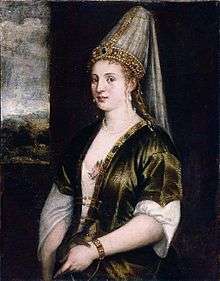 Portrait by Titian titled La Sultana Rossa, c. 1550 | |||||
| Haseki Sultan of the Ottoman Empire (Imperial Consort) | |||||
| Tenure | 1533/1534 – 15 April 1558 | ||||
| Predecessor | position established | ||||
| Successor | Nurbanu Sultan | ||||
| Born | c. 1502–1504 Rohatyn, Ruthenia, Kingdom of Poland | ||||
| Died | 15 April 1558 (aged 53–56) Topkapı Palace, Istanbul, Ottoman Empire | ||||
| Burial | Süleymaniye Mosque, Istanbul | ||||
| Spouse | Suleiman the Magnificent | ||||
| Issue | |||||
| |||||
| Father | ? Lisovsky[1] | ||||
| Religion | Sunni Islam, previously Eastern Orthodox Christian | ||||
Born in Ruthenia (then an eastern region of the Kingdom of Poland), Hurrem was captured by Crimean Tatars during a slave raid and eventually taken to Istanbul, the Ottoman capital. She entered the Imperial Harem, rising through the ranks to become the favourite of Sultan Suleiman. Breaking with Ottoman tradition, Suleiman married Hurrem, making her his legal wife. She was the first imperial consort to receive the title Haseki Sultan. Hurrem remained in the Sultan's court for the rest of her life and had six children with him, including the future Sultan Selim II. She was the grandmother of Murad III.
Hurrem achieved power and influenced the politics of the Ottoman Empire through her husband, playing an active role in the affairs of the Empire. She acted as the Sultan's chief advisor, corresponded on state matters with King Sigismund II Augustus of Poland (r. 1548–1572), and patronized major public works (which included the Haseki Sultan Complex and the Hurrem Sultan Bathhouse). She died in 1558 in Istanbul and was buried in a mausoleum within the Süleymaniye Mosque complex.
Names
Hurrem's birth name is unknown. Leslie P. Peirce has written that it may have been either Anastasia, or Aleksandra Lisowska.[2] Among the Ottomans, she was known mainly as Haseki Hurrem Sultan or Hurrem Haseki Sultan. Hurrem or Khorram (Persian: خرم) means "the cheerful one" in Persian.
Origin
Sources indicate that Hurrem Sultan was originally from Ruthenia, which was then occupied by the Polish Crown.[3] She was born in the town of Rohatyn 68 km (42 mi) southeast of Lwów, a major city of the Ruthenian Voivodeship in the Crown of the Kingdom of Poland.[4] According to late 16th-century and early 17th-century sources, such as the Polish poet Samuel Twardowski (died 1661), who researched the subject in Turkey, Hurrem was seemingly born to a man surnamed Lisovsky, who was an Orthodox priest of Ruthenian origin.[4][5][6] Her native language was Ruthenian.[7]
In the 1510s, Crimean Tatars kidnapped her during one of their Crimean–Nogai slave raids in Eastern Europe. The Tatars may have first taken her to the Crimean city of Kaffa, a major centre of the Ottoman slave trade, before she was taken to Istanbul.[4][5][6] In Istanbul, Valide Hafsa Sultan selected Hurrem as a gift for her son, Suleiman. Hurrem later managed to become the Haseki Sultan or "favorite concubine" of the Ottoman imperial harem.[3] Michalo Lituanus wrote in the 16th century that "the most beloved wife of the present Turkish emperor – mother of his primogenital [son] who will govern after him, was kidnapped from our land".[lower-roman 1][8]
Shaykh Qutb al-Din al-Nahrawali, a Meccan religious figure, who visited Istanbul in late 1557, noted in his memoirs that Hurrem Sultan was of Ruthenian origin. She had been a servant in the household of Hançerli Fatma Sultan, daughter of Şehzade Mahmud, son of Sultan Bayezid II. She was presented to Suleiman when he was still a prince.[9]
Relationship with Suleiman
Roxelana, called Hurrem Sultan by the Ottomans, probably entered the harem around fifteen years of age. The precise year that she entered the harem is unknown, but scholars believe that she became Suleiman's concubine around the time he became sultan in 1520.[10]
Hurrem's unprecedented rise from harem slave to Suleiman's legal wife and "queen of the Ottoman Empire" attracted jealousy and disfavor not only from her rivals in the harem, but also from the general populace.[3] She soon became Suleiman's most prominent consort beside Mahidevran Sultan (also known as Gülbahar). While the exact dates for the births of her children are disputed, there is academic consensus that the births of her five children —Şehzade Mehmed, Mihrimah Sultan, Şehzade Abdullah, Sultan Selim II and Şehzade Bayezid — occurred quickly over the next four to five years.[10]:130 Suleiman and Hurrem's last child, Şehzade Cihangir was born with a hunchback, but by that time Hurrem had borne enough healthy sons to secure the future of the Ottoman dynasty.[10]:131
Her joyful spirit and playful temperament earned her a new name, Hurrem, from Persian Khorram, "the cheerful one". In the Istanbul harem, Hurrem became a rival to Mahidevran and her influence over the Sultan soon became legendary. Hurrem was allowed to give birth to more than one son which was a stark violation of the old imperial harem principle, "one concubine mother — one son," which was designed to prevent both the mother's influence over the sultan and the feuds of the blood brothers for the throne.[8] She was to bear the majority of Suleiman's children. Hurrem gave birth to her first son Mehmed in 1521 (who died in 1543) and then to four more sons, destroying Mahidevran's status as the mother of the sultan's only son.[11] Suleiman's mother, Hafsa Sultan, partially suppressed the rivalry between the two women.[12] According to Bernardo Navagero's report, as a result of the bitter rivalry a fight between the two women broke out, with Mahidevran beating Hurrem, which angered Suleiman.[13] According to Necdet Sakaoğlu, a Turkish historian, these accusations were not truthful.
In 1533 or 1534 (the exact date is unknown),[8] Suleiman married Hurrem in a magnificent formal ceremony. Never before was a former slave elevated to the status of the sultan's lawful spouse, much to the astonishment of observers in the palace and in the city.[14] Hurrem also received the title Haseki Sultan and became the first consort to hold this title.[15] This title, used for a century, reflected the great power of imperial consorts (most of them were former slaves) in the Ottoman court, elevating their status higher than Ottoman princesses, and making them the equals of empresses consort in Europe. In this case, Suleiman not only broke the old custom, but created new tradition for the future Ottoman Sultans to marry with a formal ceremony and make their consorts have significant influence on the court, especially in matter of succession. Hurrem's salary was 2,000 aspers a day, making her one of the highest paid hasekis.[8] Their marriage had subsequent consequences including creating a general belief that by this marriage the Sultan had limited his autonomy and was dominated and controlled by his wife.[16] Furthermore, a mother's role in educating and guiding her sons throughout their life became more prominent.[16]
Later, Hurrem became the first woman to remain in the Sultan's court for the duration of her life. In the Ottoman imperial family tradition, a sultan's consort was to remain in the harem only until her son came of age (around 16 or 17), after which he would be sent away from the capital to govern a faraway province, and his mother would follow him. This tradition was called Sancak Beyliği. The consorts were never to return to Istanbul unless their sons succeeded to the throne.[17] In defiance of this age-old custom, Hurrem stayed behind in the harem, even after her sons went to govern the empire's remote provinces.
Moreover, in addition to remaining in Istanbul, she also moved out of the harem located in the Old Palace (Eski Saray) and permanently moved into the Topkapı Palace after a fire destroyed the old harem. Some sources say she moved to Topkapı, not because of the fire, but as a result of her marriage to Suleiman. Either way, this was another significant break from established customs, as Sultan Mehmed the Conqueror had specifically issued a decree to the effect that no women would be allowed to reside in the same building where government affairs were conducted.[10]:131 After Hürrem resided at Topkapı it became known as the New Palace (saray-ı jedid).[18]
Under his pen name, Muhibbi, Sultan Suleiman composed this poem for Hurrem Sultan:
"Throne of my lonely niche, my wealth, my love, my moonlight.
My most sincere friend, my confidant, my very existence, my Sultan, my one and only love.
The most beautiful among the beautiful...
My springtime, my merry faced love, my daytime, my sweetheart, laughing leaf...
My plants, my sweet, my rose, the one only who does not distress me in this world...
My Istanbul, my Caraman, the earth of my Anatolia
My Badakhshan, my Baghdad and Khorasan
My woman of the beautiful hair, my love of the slanted brow, my love of eyes full of mischief...
I'll sing your praises always
I, lover of the tormented heart, Muhibbi of the eyes full of tears, I am happy."[19]
State affairs
Hurrem became Suleiman's partner not only in the Sultan's household, but also in state affairs. Thanks to her intelligence, she acted as Suleiman's chief adviser on matters of state, and seems to have had an influence upon foreign policy and international politics. She frequently accompanied him as a political adviser. Hurrem's influence on Suleiman was so significant that rumors circulated around the Ottoman court that the sultan had been bewitched.[3]
Her influence with Suleiman made her one of the most powerful women in Ottoman history and in the world at that time. Even as a consort, her power was comparable with the most powerful woman of the Imperial Harem, who by tradition was the Sultan's mother or valide sultan. For this reason, she has become a controversial figure in Ottoman history — subject to allegations of plotting against and manipulating her political rivals.
Controversial figure
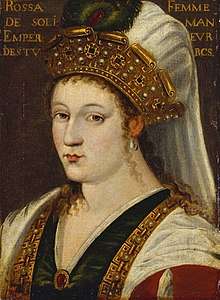
Hurrem's influence in state affairs not only made her one of the most influential women, but also a controversial figure in Ottoman history, especially in her rivalry with Mahidevran Hatun and her son Şehzade Mustafa, Pargalı Ibrahim Pasha, and Kara Ahmed Pasha.
Hurrem and Mahidevran had borne Suleiman six şehzades (Ottoman princes), four of whom survived past the 1550s: Mustafa, Selim, Bayezid, and Cihangir. Of these, Mahidevran's son Mustafa was the eldest and preceded Hurrem's children in the order of succession. Traditionally, when a new sultan rose to power, all of his brothers were killed in order to ensure the stability of the empire. This practice is called kardeş katliamı.[20]
Mustafa was supported by Ibrahim Pasha, who became Suleiman's Grand Vizier in 1523. Hurrem has usually been held at least partly responsible for the intrigues in nominating a successor.[10]:132 Although she was Suleiman's wife, she exercised no official public role. This did not, however, prevent Hurrem from wielding powerful political influence. Since the empire lacked, until the reign of Ahmed I (1603–1617), any formal means of nominating a successor, successions usually involved the death of competing princes in order to avert civil unrest and rebellions. In attempting to avoid the execution of her sons, Hurrem used her influence to eliminate those who supported Mustafa's accession to the throne.[21]
A skilled commander of Suleiman's army, Ibrahim eventually fell from grace after an imprudence committed during a campaign against the Persian Safavid empire during the Ottoman–Safavid War (1532–55), when he awarded himself a title including the word "Sultan". Another conflict occurred when Ibrahim and his former mentor, İskender Çelebi, repeatedly clashed over military leadership and positions during the Safavid war. These incidents launched a series of events which culminated in his execution in 1536 by Suleiman's order. It is believed that Hurrem's influence contributed to Suleiman's decision.[22] After three other grand viziers in eight years, Suleiman selected Hurrem's son-in-law, Damat Rüstem Pasha, husband of Mihrimah, to become the grand vizier. Scholars have wondered if Hurrem's alliance with Mihrimah Sultan and Rüstem Pasha helped secure the throne for one of Hurrem's sons.[10]:132
Many years later, towards the end of Suleiman's long reign, the rivalry between his sons became evident. Mustafa was later accused of causing unrest. During the campaign against Safavid Persia in 1553, because of fear of rebellion, Suleiman ordered the execution of Mustafa. According to a source he was executed that very year on charges of planning to dethrone his father; his guilt for the treason of which he was accused remains neither proven nor disproven.[23] After the death of Mustafa, Mahidevran lost her status in the palace as the mother of the heir apparent and moved to Bursa.[11] She did not spend her last years in poverty, as her stepson, Selim II, the new sultan after 1566, put her on a lavish salary.[23] Her rehabilitation had been possible after the death of Hurrem in 1558.[23] Cihangir, Hurrem's youngest child, allegedly died of grief a few months after the news of his half-brother's murder.[24]
Although the stories about Hurrem's role in executions of Ibrahim, Mustafa, and Kara Ahmed are very popular, actually none of them are based on first-hand sources. All other depictions of Hurrem, starting with comments by sixteenth and seventeenth-century Ottoman historians as well as by European diplomats, observers, and travellers, are highly derivative and speculative in nature. Because none of these people – neither Ottomans nor foreign visitors – were permitted into the inner circle of the imperial harem, which was surrounded by multiple walls, they largely relied on the testimony of the servants or courtiers or on the popular gossip circulating around Istanbul. Even the reports of the Venetian ambassadors (baili) at Suleiman's court, the most extensive and objective first-hand Western source on Hurrem to date, were often filled with the authors’ own interpretations of the harem rumours. Most other sixteenth-century Western sources on Hurrem, which are considered highly authoritative today — such as Turcicae epistolae (English: The Turkish Letters) of Ogier de Busbecq, the Emissary of the Holy Roman Emperor Ferdinand I at the Porte between 1554 and 1562; the account of the murder of Şehzade Mustafa by Nicholas de Moffan; the historical chronicles on Turkey by Paolo Giovio; and the travel narrative by Luidgi Bassano — derived from hearsay.[8]
Foreign policy
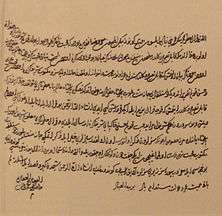
Hurrem acted as Suleiman's advisor on matters of state, and seems to have had an influence upon foreign policy and on international politics. Two of her letters to King Sigismund II Augustus of Poland (reigned 1548–1572) have survived, and during her lifetime the Ottoman Empire generally had peaceful relations with the Polish state within a Polish–Ottoman alliance.
In her first short letter to Sigismund II, Hurrem expresses her highest joy and congratulations to the new king on the occasion of his ascension to the Polish throne after the death of his father Sigismund I the Old in 1548. She also pleads with the King to trust her envoy Hassan Ağa who took another message from her by word of mouth. In her second letter to Sigismund Augustus, written in response to his letter, Hurrem expresses in superlative terms her joy at hearing that the king is in good health and that he sends assurances of his sincere friendliness and attachment towards Sultan Suleiman the Magnificent. She also quotes the sultan as saying, "with the old king we were like brothers, and if it pleases the All-Merciful God, with this king we will be as father and son." With this letter, Hurrem sent Sigismund II the gift of two pairs of linen shirts and pants, some belts, six handkerchiefs, and a hand-towel, with a promise to send a special linen robe in the future.
There are reasons to believe that these two letters were more than just diplomatic gestures, and that Suleiman's references to brotherly or fatherly feelings were not a mere tribute to political expediency. The letters also suggest Hurrem's strong desire to establish personal contact with the king. In his 1551 letter to Sigismund II concerning the embassy of Piotr Opaliński, Suleiman wrote that the Ambassador had seen "Your sister and my wife." Whether this phrase refers to a warm friendship between the Polish King and Ottoman Haseki, or whether it suggests a closer relation, the degree of their intimacy definitely points to a special link between the two states at the time.[8]
Charities
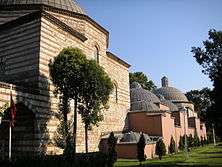
Aside from her political concerns, Hurrem engaged in several major works of public buildings, from Mecca to Jerusalem, perhaps modelling her charitable foundations in part after the caliph Harun al-Rashid's consort Zubaida. Among her first foundations were a mosque, two Koranic schools (madrassa), a fountain, and a women's hospital near the women's slave market (Avret Pazary) in Istanbul (Haseki Sultan Complex). It was the first complex constructed in Istanbul by Mimar Sinan in his new position as the chief imperial architect. She also built mosque complexes in Adrianopole and Ankara.
She commissioned a bath, the Hurrem Sultan Bathhouse, to serve the community of worshippers in the nearby Hagia Sophia.[25] In Jerusalem she established in 1552 the Haseki Sultan Imaret, a public soup kitchen to feed the poor,[26] which was said to have fed at least 500 people twice a day.[27] She also built a public soup kitchen in Mecca.[8]
She had a Kira who acted as her secretary and intermediary on several occasions, although the identity of the kira is uncertain (it may have been Strongilah[28] or Esther Handali).
Death
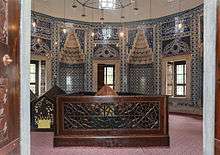
Hurrem died on 15 April 1558 and was buried in a domed mausoleum (türbe) decorated in exquisite Iznik tiles depicting the garden of paradise, perhaps in homage to her smiling and joyful nature.[29] Her mausoleum is adjacent to Suleiman's, a separate and more somber domed structure, at the courtyard of the Süleymaniye Mosque.
Personality
Hurrem's contemporaries describe her as a woman who was strikingly good-looking, and different from everybody else because of her gorgeous red hair.[30] Hurrem was also intelligent and had a sparkling personality. She loved poetry very much and that is considered as one of the reasons behind her being heavily favoured by Suleiman, who was a great admirer of poetry.[30]
Hurrem is known to have been very generous to the poor. She built numerous mosques, madrasahs, hammams, and resting places for pilgrims travelling to the Islamic holy city of Mecca. Her greatest philanthropical work was the Great Waqf of Jerusalem, a big soup kitchen that fed the poor and the needy.[31]
It is believed that Hurrem was a cunning, manipulative and stony-hearted woman who would execute anyone who stood in her way. However, her philanthropy says otherwise as she cared for the poor and hungry; she was genuine and softhearted. Prominent Ukranian writer Pavlo Zahrebelny describes Hurrem as "an intelligent, kind, understanding, openhearted, candied, talented, generous, emotional and grateful woman who cares about the soul rather than the body; who is not carried away with ordinary glimmers such as money, prone to science and art; in short, a perfect woman."[32]
Legacy
Hurrem Haseki Sultan, or Roxelana, is well-known both in modern Turkey and in the West, and is the subject of many artistic works. In 1561, three years after Hurrem's death, the French author Gabriel Bounin wrote a tragedy titled La Soltane.[33] This tragedy marks the first time the Ottomans were introduced on stage in France.[34] She has inspired paintings, musical works (including Joseph Haydn's Symphony No. 63), an opera by Denys Sichynsky, a ballet, plays, and several novels written mainly in Russian and Ukrainian, but also in English, French, German and Polish.
The Venetian painter Titian is reputed to have painted her. Although he never visited Istanbul, he either imagined her appearance or had a sketch of her. In a letter to Philip II of Spain, the painter claims to have sent him a copy of this "Queen of Persia" in 1552. The Ringling Museum in Sarasota, Florida, purchased the original or a copy around 1930[35]
In early modern Spain, she appears or is alluded to in works by Quevedo and other writers as well as in a number of plays by Lope de Vega. In a play entitled The Holy League, Titian appears on stage at the Venetian Senate, and stating that he has just come from visiting the Sultan, displays his painting of Sultana Rossa or Roxelana.[36]
In 2007, Muslims in Mariupol, a port city since 1922 in Ukraine opened a mosque to honour Roxelana.[37]
In the 2003 TV miniseries, Hürrem Sultan, she was played by Turkish actress and singer Gülben Ergen. In the 2011–2014 TV series Muhteşem Yüzyıl, Hurrem Sultan is portrayed by Turkish-German actress Meryem Uzerli from season one to season three and at the series' last season she is portrayed by Turkish actress Vahide Perçin.
In 2019, mention of the Russian origin of Hurrem Sultan was removed from the visitor panel near her tomb at the Süleymaniye Mosque in Istanbul at the request of the Ukrainian Embassy in Turkey.[38]
Issue
With Süleyman, she had five sons and one daughter.
- Mehmed (31 October 1522 – 6 November 1543): Hurrem's first son. Born in 1521 at Istanbul. Mehmed became the ruler of Manisa from 1541 until his death.
- Mihrimah (c. 1523 – 25 January 1578): Hurrem's only daughter. She was married to Rüstem, later Ottoman Grand Vizier, on 26 November 1539.
- Abdullah (c. 1523 – 1526), (possibly)
- Selim (30 May 1524 – 12/15 December 1574): He was governor of Manisa after Mehmed's death and later governor of Konya. He ascended to the throne on 7 September 1566 as Selim II.
- Bayezid (1525 – 25 September 1561): He was governor of Kütahya and later Amasya.
- Cihangir (9 December 1531 – 27 November 1553)
Gallery
 16th century Latin oil painting of Hurrem Sultan titled Rosa Solymanni Vxor (Rosa, Süleyman's Wife)
16th century Latin oil painting of Hurrem Sultan titled Rosa Solymanni Vxor (Rosa, Süleyman's Wife) 18th century portrait of Hurrem Sultan kept at Topkapı Palace.
18th century portrait of Hurrem Sultan kept at Topkapı Palace.- Roxelana and Süleyman the Magnificent by the German baroque painter Anton Hickel, (1780)
 Engraving by Johann Theodor de Bry, (1596)
Engraving by Johann Theodor de Bry, (1596) 16th century oil on wood painting of Hurrem Sultan
16th century oil on wood painting of Hurrem Sultan Tribute to Roxelana on 1997 Ukrainian postage stamp
Tribute to Roxelana on 1997 Ukrainian postage stamp
See also
Notes
- The title of his book is De moribus tartarorum, lituanorum et moscorum or On the customs of Tatars, Lithuanians and Moscovians.
References
- Dr Galina I Yermolenko (2013). Roxolana in European Literature, History and Culturea. Ashgate Publishing, Ltd. p. 275. ISBN 978-1-409-47611-5. Archived from the original on 2017-01-14.
- Leslie P. Peirce, The imperial harem: women and sovereignty in the Ottoman Empire Archived 2017-01-14 at the Wayback Machine, Oxford University Press US, 1993, ISBN 0-19-508677-5, pp. 58-59.
- Bonnie G. Smith, ed. (2008). "Hürrem, Sultan". The Oxford Encyclopedia of Women in World History. Oxford University Press. ISBN 9780195148909. Retrieved 2017-05-29.
- Abbott, Elizabeth (2011-09-01). Mistresses: A History of the Other Woman. Overlook. ISBN 978-1-59020-876-2.
- "The Speech of Ibrahim at the Coronation of Maximilian II", Thomas Conley, Rhetorica: A Journal of the History of Rhetoric, Vol. 20, No. 3 (Summer 2002), 266.
- Kemal H. Karpat, Studies on Ottoman Social and Political History: Selected Articles and Essays, (Brill, 2002), 756.
- Yermolenko, Galina I. (February 13, 2010). Roxolana in European Literature, History and Culture. Ashgate Publishing, Ltd. ISBN 9781409403746 – via Google Books.
- Yermolenko, Galina (April 2005). "Roxolana: 'The Greatest Empresse of the East'". The Muslim World. 95 (2). doi:10.1111/j.1478-1913.2005.00088.x.
- Nahrawālī, Muḥammad ibn Aḥmad; Blackburn, Richard (2005). Journey to the Sublime Porte: the Arabic memoir of a Sharifian agent's diplomatic mission to the Ottoman Imperial Court in the era of Suleyman the Magnificent; the relevant text from Quṭb al-Dīn al-Nahrawālī's al-Fawāʼid al-sanīyah fī al-riḥlah al-Madanīyah wa al-Rūmīyah. Orient-Institut. pp. 200, 201 and n. 546. ISBN 978-3-899-13441-4.
- Levin, Carole (2011). Extraordinary women of the Medieval and Renaissance world: a biographical dictionary. Westport, Conn. [u.a.: Greenwood Press. ISBN 978-0-313-30659-4.
- "Ottoman Empire History Encyclopedia - Letter H - Ottoman Turkish history with pictures - Learn Turkish". www.practicalturkish.com. Archived from the original on 2008-06-01.
- Selçuk Aksin Somel: Historical Dictionary of the Ottoman Empire, Oxford, 2003, ISBN 0-8108-4332-3, p. 123
- Peirce 1993, p. 59-60.
- Mansel, Philip (1998). Constantinople : City of the World's Desire, 1453–1924. New York: St. Martin's Griffin. ISBN 978-0-312-18708-8. p, 86.
- Peirce 1993, p. 91.
- Peirce 1993, p. 109.
- Imber, Colin (2002). The Ottoman Empire, 1300–1650 : The Structure of Power. New York: Palgrave Macmillan. ISBN 978-0-333-61386-3. p, 90.
- Peirce 1993, p. 119.
- "A Message For The Sultan - Sample Activity (Women in World History Curriculum)". www.womeninworldhistory.com. Archived from the original on June 8, 2007.
- Akman, Mehmet (1997-01-01). Osmanlı devletinde kardeş katli. Eren. ISBN 978-975-7622-65-9.
- Mansel, Phillip (1998). Constantinople : City of the World's Desire, 1453–1924. New York: St. Martin's Griffin. p. 84. ISBN 978-0-312-18708-8.
- Mansel, 87.
- Peirce, 55.
- Mansel, 89.
- "Historical Architectural Texture". Ayasofya Hürrem Sultan Hamamı. Archived from the original on 20 November 2015. Retrieved 19 November 2015.
- Peri, Oded. Waqf and Ottoman Welfare Policy, The Poor Kitchen of Hasseki Sultan in Eighteenth-Century Jerusalem, pg 169
- Singer, Amy. Serving Up Charity: The Ottoman Public Kitchen, pg 486
- Minna Rozen: A History of the Jewish Community in Istanbul, The Formative Years, 1453 – 1566 (2002).
- Öztuna, Yılmaz (1978). Şehzade Mustafa. İstanbul: Ötüken Yayınevi. ISBN 9754371415.
- Talhami, Ghada. Historical Dictionaries of Women in the World: Historical Dictionary of Women in the Middle East and North Africa. Scarecrow Press, 2012. p. 271
- Talhami, Ghada. Historical Dictionaries of Women in the World: Historical Dictionary of Women in the Middle East and North Africa. Scarecrow Press, 2012. p. 272
- Chitchi, S. "Orientalist view on the Ottoman in the novel Roxalana (Hurrem Sultan) by Ukrainan author Pavlo Arhipovich Zahrebelniy". The Journal of International Social Research Vol. 7, Issue 33, p. 64
- The Literature of the French Renaissance by Arthur Augustus Tilley, p.87 Tilley, Arthur Augustus (December 2008). The Literature of the French Renaissance. ISBN 9780559890888. Archived from the original on 2014-09-20. Retrieved 2015-07-01.
- The Penny cyclopædia of the Society for the Diffusion of Useful Knowledge p.418 Penny Cyclopaedia of the Society for the Diffusion of Useful Knowledge. 1838. Archived from the original on 2014-09-20. Retrieved 2015-07-01.
- Harold Edwin Wethey The Paintings of Titian: The Portraits, Phaidon, 1971, p. 275.
- Frederick A. de Armas "The Allure of the Oriental Other: Titian's Rossa Sultana and Lope de Vega's La santa Liga," Brave New Words. Studies in Spanish Golden Age Literature, eds. Edward H. Friedman and Catherine Larson. New Orleans: UP of the South, 1996: 191-208.
- "Religious Information Service of Ukraine". Archived from the original on 2012-12-22.
- "Reference to Roxelana's Russian origin removed from label near her tomb in Istanbul at Ukraine's request". Interfax-Ukraine. 26 January 2019. Retrieved 2019-01-28.
Further reading
- Peirce, Leslie (1993). Empress of the East: How a European Slave Girl Became Queen of the Ottoman Empire. New York Basic Books. ISBN 978-0-465-03251-8.CS1 maint: ref=harv (link).
- There are many historical novels in English about Roxelana: P.J. Parker's Roxelana and Suleyman[1] (2012; Revised 2016); Barbara Chase Riboud's Valide (1986); Alum Bati's Harem Secrets (2008); Colin Falconer, Aileen Crawley (1981–83), and Louis Gardel (2003); Pawn in Frankincense, the fourth book of the Lymond Chronicles by Dorothy Dunnett; and pulp fiction author Robert E. Howard in The Shadow of the Vulture imagined Roxelana to be sister to its fiery-tempered female protagonist, Red Sonya.
- David Chataignier, "Roxelane on the French Tragic Stage (1561-1681)" in Fortune and Fatality: Performing the Tragic in Early Modern France, ed. Desmond Hosford and Charles Wrightington (Newcastle upon Tyne: Cambridge Scholars Publishing, 2008), 95-117.
- Thomas M. Prymak, "Roxolana: Wife of Suleiman the Magnificent," Nashe zhyttia/Our Life, LII, 10 (New York, 1995), 15–20. An illustrated popular-style article in English with a bibliography.
- Zygmunt Abrahamowicz, "Roksolana," Polski Slownik Biograficzny, vo. XXXI (Wroclaw-etc., 1988–89), 543–5. A well-informed article in Polish by a distinguished Polish Turkologist.
- Galina Yermolenko, "Roxolana: The Greatest Empresse of the East," The Muslim World, 95, 2 (2005), 231–48. Makes good use of European, especially Italian, sources and is familiar with the literature in Ukrainian and Polish.
- Galina Yermolenko (ed.), Roxolana in European Literature, History and Culture (Farmham, UK: Ashgate, 2010). 318 pp. Illustrated. Contains important articles by Oleksander Halenko and others, as well as several translations of works about Roxelana from various European literatures, and an extensive bibliography.
- For Ukrainian language novels, see Osyp Nazaruk (1930) (English translation is available),[2] Mykola Lazorsky (1965), Serhii Plachynda (1968), and Pavlo Zahrebelnyi (1980).
- There have been novels written in other languages: in French, a fictionalized biography by Willy Sperco (1972); in German, a novel by Johannes Tralow (1944, reprinted many times); a very detailed novel in Serbo-Croatian by Radovan Samardzic (1987); one in Turkish by Ulku Cahit (2001).
References
- "Roxelana and Suleyman". www.facebook.com. Archived from the original on 2017-01-14.
- Nazaruk, Osyp. "Roxelana" – via Amazon.
External links
| Wikimedia Commons has media related to Hurrem Sultan. |
| Ottoman royalty | ||
|---|---|---|
| New title position established |
Haseki Sultan 1533/1534 – 15 April 1558 |
Succeeded by Nurbanu Sultan |

